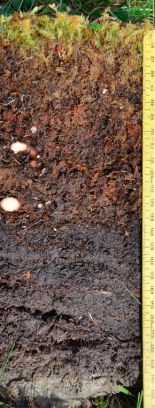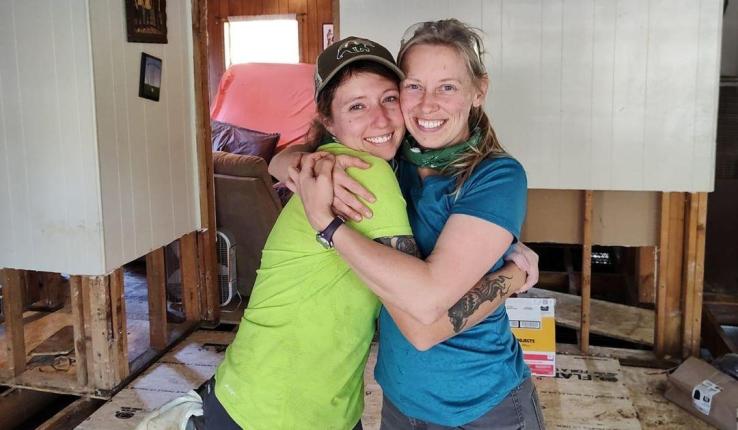Peat Expansion in the Arctic Tundra Could Play a Role in Cooling a Warming Planet

Arctic tundra dominated by tussock cotton-grass (Eriophorum vaginatum) with reddish peat moss (Sphagnum rubellum) peat patches on a hillslope at Imnavait Creek (Toolik LTER) on the North Slope, Alaska. Scientists working on MacroSystem Biology's TundraPEAT project study the dynamics and formation processes of these initial peat-forming ecosystems across the Arctic and their carbon-cycle implications. Photo taken in summer 2013.
Could studying the peat moss that grows in the Arctic Tundra help mitigate the impacts of climate change?
Several factors point to: Yes.
Today, the National Science Foundation (NSF) announced that, as part of its 2018 awards, it is supporting a study of the rapidly changing Arctic that will track the dynamics of peatlands as part of one of its ten “Big Ideas” for scientists to tackle: Navigating the New Arctic.
Peat moss—Sphagnum—is known to be a “carbon sink,” which means it absorbs carbon dioxide from the atmosphere. Carbon sinks like peat moss are increasingly being understood as a way to mitigate, or slow, the rapid warming of the planet.
According to Zicheng Yu, professor of earth and environmental sciences, if shallow peatlands are widespread throughout the Arctic, the overall net carbon storage capacity of tundra might be underestimated globally.
Yu is principal investigator on the project, in collaboration with faculty from Texas A&M University, Bowdoin College, the University of New Hampshire and Purdue University, to study the expansion of peat in the Arctic Tundra, its patterns and development process, and the implications of such an expansion on the carbon cycle.
In recent years, scientists have observed that the Arctic—consisting of the northern parts of Canada, Alaska and Siberia—is getting greener, resembling the ecosystem of warmer climates, such as the Boreal Forests, an area just south of the treeless Tundra.
However, the factors controlling the formation, distribution, and dynamics of peat patches in the Arctic Tundra are poorly understood, according to Yu. Yu, a paleoecologist and paleoclimatologist has, over the last few years, worked on Holocene paleoclimate variations and associated peat carbon accumulation dynamics in continental peatlands using high-resolution carbon dating and paleoecological records.
During a recent trip to the Arctic, Yu and his students at Lehigh found abundant peat moss patches on the hillslopes on the North Slope of Alaska. However, it is not known how widespread these patches are, why they are there and what factors control their formation, distribution and dynamics.
“We know that peatlands have been an important carbon sink over multi-millennial timescales,” says Yu. “However, we don't know how they respond to recent and future environmental changes at decadal-centennial timescales, the most relevant timescales of rapid Arctic climate change and for climate change mitigation. Furthermore, we don't understand the possible cross-timescale interactions between plant production and peat decomposition processes.”
Yu and his collaborators will seek to illuminate these timescale interactions and processes. The goal is to answer the overarching question: Will the warming Arctic transform into a peat-rich landscape, as the boreal zone is now, or are there essential conditions lacking in a warming Arctic that will prevent this?
NSF is funding the project through its MacroSystems Biology and Early NEON (National Ecological Observatory Network) Science programs. According to NSF, these awards will support research that helps understand biosphere processes and their complex interactions with climate, land use, and invasive species at regional to continental scales.
In its announcement, NSF notes that the research will assess implications for global climate models and will address one of NSF's “Ten Big Ideas”: Navigating the New Arctic.
A goal of Navigating the New Arctic is to establish an observing network of mobile and fixed platforms and tools across the Arctic to document and understand the Arctic's rapid biological, physical, chemical and social changes.
Yu and the research team plan to integrate new data collection from multiple tundra sites along the northernmost peat-forming frontiers of the North American Arctic. They will also conduct laboratory incubation experiments, synthesizing existing data from the tundra and boreal biomes, and ecosystem-scale process model simulations.
Their research will focus on two key elements of the Arctic peat-forming ecosystems: peat patches, and the role of Sphagnum in the formation, persistence and rapid rates of carbon sequestration of these potentially incipient peatlands.
It is likely that their work on this topic will have broader impacts.
Adds Yu: “The research proposed here directly addresses an urgent global change question concerned with Arctic terrestrial ecosystems and their relationship to the global carbon cycle and the global climate system.”
Images courtesy of Zicheng Yu, Lehigh University
Posted on:






